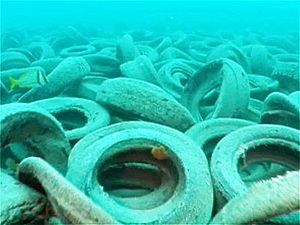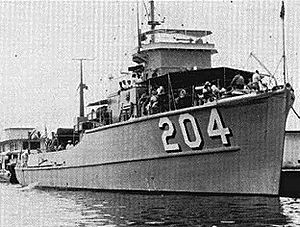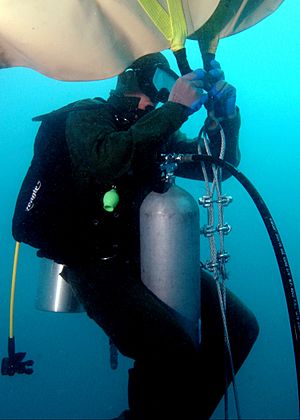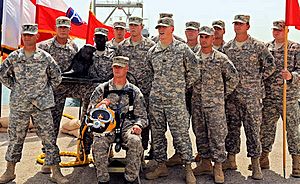Osborne Reef facts for kids
Quick facts for kids Osborne Reef |
|
|---|---|

Underwater photo of the reef tires (2007)
|
|
| Type of project | Artificial reef |
| Location | Off the coast of Fort Lauderdale, Florida, US 26°06′27″N 80°03′54″W / 26.10748°N 80.06493°W |
| Website | Lua error in Module:Wikidata at line 70: attempt to index field 'wikibase' (a nil value). |
Osborne Reef is an artificial reef located near Fort Lauderdale, Florida. It was first built using concrete blocks. Later, a big project tried to expand it using old car tires. This expansion didn't work out. Now, Osborne Reef is known as an environmental disaster because it caused more harm than good to the ocean near Florida.
In 2007, after some delays, cleanup work began. The United States military helped with the project. This cleanup gave military divers and recovery teams real-world training. It also helped the Florida coast without costing the state too much money. In 2015, a private company took over. By November 2019, they had removed about one-third of the tires.
Contents
Building the Reef
The first part of Osborne Reef was made from concrete blocks. These blocks were placed in a circle about 50 feet wide.
Adding Tires to the Reef
In 1972, a company called Broward Artificial Reef Inc. (BARINC) suggested making the artificial reef much bigger. They told Broward County that this would be a good way to get rid of old tires. It would also attract more game fish to the area. Similar reefs had been built in other places like the Northeastern United States, the Gulf of Mexico, Indonesia, Malaysia, Australia, and Africa.
A BARINC employee named Gregory McIntosh spoke about the project in 1974. He said, "Tires, which were ugly trash on land, could be reused to build a fishing reef in the sea."
The United States Army Corps of Engineers supported the project. So, the Broward County government approved it in 1974. That spring, more than 100 private boats volunteered to help. The US Navy ship USS Thrush also joined in. Together, they dropped thousands of tire bundles onto the reef. The Goodyear Tire and Rubber Company provided equipment. They even dropped a gold-painted tire from a Goodyear Blimp to celebrate the start of the project.
In total, over two million tires were placed on the ocean floor. They were tied together with steel clips. The tires covered about 36 acres of the seabed. This area was about 7,000 feet offshore and 65 feet deep.
Why the Reef Failed
The really good idea was to provide habitat for marine critters so we could double or triple marine life in the area, [...] It just didn't work that way. I look back now and see it was a bad idea.
Sadly, very little sea life was able to grow on the man-made tire reef. Most marine creatures never even had a chance to attach to it. When the tires were first dropped, some were loose. But most were tied together with nylon or steel clips.
The problem was that the steel clips were not made to resist rust. So, they quickly broke apart. This caused over two million individual, lightweight tires to become loose. These loose tires moved around and destroyed any sea life that had started to grow on them. They also stopped new organisms from growing.
Because the tires were now loose, they were easily moved by tropical winds and storms. These storms often hit the east coast of Florida. The tires kept crashing into natural coral reefs nearby, which were only about 70 feet away. This made the problem worse, causing damage to the environment.
Also, people in nearby coastal areas worried that the tires were not staying within the Osborne Reef boundaries. In 1995, Hurricane Opal spread over 1,000 tires onto the Florida Panhandle. This area is west of Pensacola. In 1998, Hurricane Bonnie dumped thousands of tires onto North Carolina beaches.
Osborne Reef is not the only tire reef project that failed. Indonesia and Malaysia started huge tire-reef programs in the 1980s. Now, they are seeing the bad results, like littered beaches and damaged reefs. Jack Sobel, who works for Ocean Conservancy, said in 2002 that he didn't know of any successful tire reefs. That year, the Ocean Conservancy's International Coastal Cleanup removed almost 12,000 tires from beaches worldwide.
Cleaning Up the Reef
You get down about 20 feet and it starts to come into sight, it's actually really-- it's like the moon or something. It's weird, it doesn't look like anything you could imagine, it's just tires for as far as you can see down there.
In 2001, Dr. Robin Sherman from Nova Southeastern University received a grant of $30,000 from the National Oceanic and Atmospheric Administration (NOAA). She used this money to start a tire removal program. She managed to remove only 1,600 tires from the reef. The estimated cost for removing each tire was about $17.
In 2002, environmental officials in Florida and Broward County began planning to remove the tires. Early estimates suggested it would cost between $40 million and $100 million. The Florida Department of Environmental Protection (DEP) planned to make a deal with companies that damaged the seabed and reefs during construction. Instead of building new reefs to make up for the damage, these companies would be asked to remove tires from Osborne Reef. However, environmental groups criticized this plan. They felt it would only lead to more destruction of ocean habitats.
US Military Helps with Cleanup
In 2007, Broward County contacted the United States Assistant Secretary of Defense for Reserve Affairs. They learned about the military's Innovative Readiness Training (IRT) program. This program looks for projects where the military can get real-world training while helping the public.
Chief Warrant Officer Donovan Motley said that cleaning up Osborne Reef was a perfect fit. He explained that the project allowed military divers and boat crews to practice "wartime" salvage operations. It also helped them work with federal, state, and county agencies. These skills would be very useful after a natural disaster, like a hurricane.
Starting in June 2007, the United States military and Coast Guard began "DiveExEast 07." This was a training exercise to figure out the best ways to clean up the reef. Military divers hoped to use this project for training for several years. Their goal was to remove as many tires as possible.
Coastal America, a US government office, helped coordinate the cleanup. They helped finalize a deal where the Florida government would provide $2 million. This money would cover transporting and recycling the tires. Ken Banks from the Florida DEP thought the project would take three to five years. While this wouldn't remove all two million tires, it would reduce most of the damage to corals and the coastline. However, Banks predicted it could take decades for the natural reefs to recover.
In the summer of 2007, divers from the US Navy, Army, and Coast Guard worked from a Coast Guard base in Dania Beach, Florida. The joint team first focused on removing tires that were pressing against natural reefs, where they caused the most damage. In 2007, they brought about 10,000 tires ashore.
In 2008, the cleanup stopped on May 24 after 26 days. By then, 43,900 tires had been removed. That year, Florida spent about $140,000 on the cleanup. Some of this money paid for transporting the tires to a shredding facility in Georgia. There, the tires were burned as fuel at a paper mill.
Key members of the 2008 cleanup were US Army Captain Russell Destremps and his 86th Engineer Dive Team. On August 10, 2009, they received the 2008 Coastal America Partnership Award. They also received a letter from US President Barack Obama for their part in cleaning up the reef. This award recognizes "outstanding partnerships that make a significant contribution toward the restoration and protection of our Nation's coastal and marine environment." It is the only environmental award of its kind given by the White House. Two days later, in Hollywood, California, Coastal America also gave the same award to the Florida Department of Environmental Protection team.
I am particularly proud of the many Sailors and Soldiers who have found a way to enhance their training on skills important to our Nation's readiness for war while also making a significant contribution to the health of our living ocean resources, [...] Just as you protect our Nation when serving overseas, at home you have found another way to protect our Nation's wellbeing.
– President Obama in his letter to Captain Destremps
In 2009, cleanup efforts started again on July 24. Thirty Army and Navy divers worked at Hugh Taylor Birch State Park. It was believed that about 300,000 tires were stuck against a natural reef there. The divers loaded the tires onto the Army boat Brandy Station. On the first day, they brought about 1,400 tires ashore. By mid-August, when the work for the year ended, Coastal America's William Nuckols told the Associated Press that about 73,000 tires had been removed from the reef so far.
Eventually, the military had to stop their cleanup at Osborne Reef because of other duties. By that time, soldiers, sailors, and coast guards had collected 72,000 tires.
Industrial Divers Corporation Takes Over
In 2015, the state hired Industrial Divers Corporation (IDC) to continue removing the tires. From 2016 to 2019, the Florida Legislature provided $4.3 million for the project. As of November 2019, IDC was removing between 2,000 and 5,000 tires each week. They had collected a total of 250,000 tires so far. However, two-thirds of the tires still remained.
See also
 In Spanish: Arrecife Osborne para niños
In Spanish: Arrecife Osborne para niños
Images for kids





